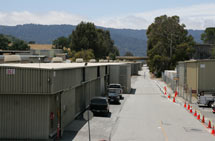
Handy Links
SLAC News Center
SLAC Today
- Subscribe
- Archives: Feb 2006-May 20, 2011
- Archives: May 23, 2011 and later
- Submit Feedback or Story Ideas
- About SLAC Today
SLAC News
Lab News
- Interactions
- Lightsources.org
- ILC NewsLine
- Int'l Science Grid This Week
- Fermilab Today
- Berkeley Lab News
- @brookhaven TODAY
- DOE Pulse
- CERN Courier
- DESY inForm
- US / LHC
SLAC Links
- Emergency
- Safety
- Policy Repository
- Site Entry Form

- Site Maps
- M & O Review
- Computing Status & Calendar
- SLAC Colloquium
- SLACspeak
- SLACspace
- SLAC Logo
- Café Menu
- Flea Market
- Web E-mail
- Marguerite Shuttle
- Discount Commuter Passes
-
Award Reporting Form
- SPIRES
- SciDoc
- Activity Groups
- Library
Stanford
Around the Bay
FACET Passes Critical Decision 1 Review
On September 10, the FACET project received approval of Critical Decision 1, CD-1, from the Department of Energy, following a successful review in July. The CD-1 approval will move the project through its initial scope, schedule and budget definition phase, and into development of a detailed engineering design.
FACET will generate extremely intense beams with peak currents of roughly 20 kA and energies in excess of 20 GeV. "These beams will be used to study many aspects of beam physics, plasma physics and materials science, however the primary goal for FACET is to understand plasma acceleration," said Tor Raubenheimer, head of SLAC's Accelerator Research Division. "In plasma acceleration, the electric field in a plasma wave is used to accelerate charged particles, such as electrons and positrons, and accelerating fields can be generated that are more than 1000 times higher than in the SLAC linac."
During the July review, the FACET team presented their strategy for constructing the facility, and laid out why their proposal would provide the best method for achieving the stated goals and answering the scientific questions posed by DOE in the Mission Need Statement in February of 2008. The CD-1 reviewers approved budget and schedule ranges for construction of the project, which for FACET was estimated between $14.5 and 16 million over 26 months.
"It's understood that this study of plasma wakefield acceleration can be done most effectively at the SLAC linear accelerator," said FACET Project Manager Andrei Seryi. Seryi said that the technical aspects of the electron and positron beams produced by the SLAC linear accelerator are unique and highly desirable for this pursuit. "If one were to start from scratch, one would need to reproduce a linear accelerator like the one at SLAC," Seryi said.
FACET has received essential support through funds from the American Recovery and Reinvestment Act. "FACET will provide revolutionary science that could transform accelerator science in the future," said FACET chief experimental scientist Mark Hogan. "It's a remarkably enabling investment in terms of the benefits we expect to realize."
As FACET moves closer to construction, so does BELLA, a plasma wakefield acceleration facility in the planning stages at Lawrence Berkeley National Laboratory. Both BELLA and FACET will study the use of plasmas to accelerate electrons and positrons, but BELLA will differ from FACET in the way it achieves this acceleration. At BELLA, a powerful laser pulse will be used to excite the plasma, where as FACET will use pulses of electrons and positrons to excite the plasma. Hogan said that he "hopes the two facilities will complement each other in finding new ways to accelerate particles to high energy over shorter distances."
The FACET team, the core of which includes about twenty SLAC physicists, engineers, safety experts, control systems specialists and more, has completed a significant amount of work on the concrete plans for FACET, including details of the new beamline to be built at sector 20 of the SLAC linac, just upstream of the LCLS injector. The beamline can be used by scientists studying not only plasma wakefield physics but other areas including materials science. The team is now working quickly to pass their CD-2 and CD-3 reviews with the DOE in the coming months, and Seryi said they hope to begin construction of the facility in early 2010.
—Calla Cofield
SLAC Today, September 21, 2009
